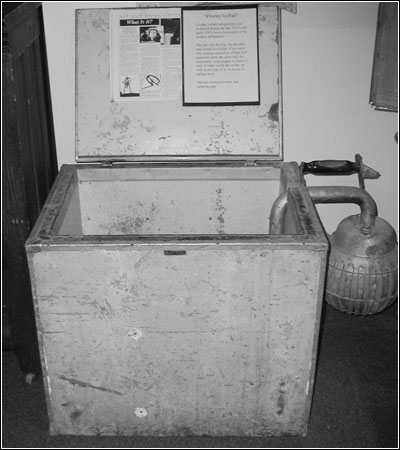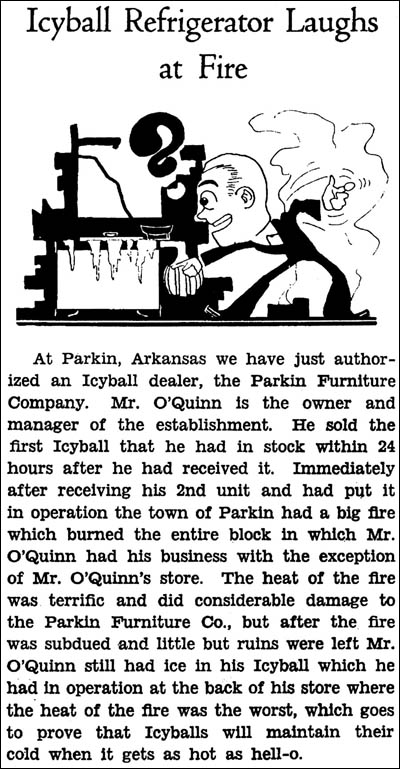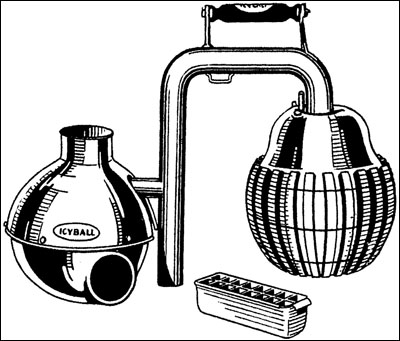Of Old Radios And Related Items--Published Monthly
The Crosley Icyball
by Ray Bintliff, W1RY
WEB EDITION
Powel Crosley's interests were not limited to radios. In the August 2004 issue of A.R.C. Dave Crocker described Crosley's Moonbeam aircraft. In this article, Ray tells us about another very different product manufactured and marketed by the Crosley Radio Corporation. (Editor)
During a visit to the Bonner County Historical Society Heritage Center in Sandpoint, Idaho, a Crosley exhibit caught my eye -- and it certainly didn't look like a radio. Upon closer inspection, I found that it was an early refrigerator that Crosley called the "Icyball."
My first thought was to call Dave Crocker, our resident Crosley expert, and find out if he knew of this early refrigerator. Of course he did. Dave offered to send me "more than I ever wanted to know about the Icyball."
When I returned home, I found copies of the The Crosley Broadcaster in the mail. The March 15, 1929, cover page, featuring the Crosley Icyball, is reproduced as Figure 1 (see print version). The June 1, 1929, issue contained a testimonial about Icyball's ability to survive a fire. That article is reproduced in a box on the opposite page.

Figure 2. An overall view of the Crosley Icyball on display in the museum in Sandpoint, Idaho.The Icyball's lift-top cabinet is made of metal and is insulated with cork. One of the two pressurized tanks or balls that make up the refrigeration system can be seen at the right side of the cabinet.
The Icyball System
The Icyball system converts heat into cold. Its closed system contains a refrigerant (a mixture of water and ammonia). In use, the "hot ball" is heated by an external heat source, typically a kerosene burner. Then the hot ball is submersed in a tub of water. The condensation and evaporation process causes the temperature of the second "cold ball" to drop to below freezing.
Figure 2 shows an overall view of the Icyball on display in the Idaho museum, while Figure 3 (see print version) shows a close-up of the unit's external hot ball. Figure 4 (see print version) shows the cold ball positioned in the Icyball's insulated cabinet.
The heating and cooling of the hot ball, referred to as "charging" is performed with the unit removed from the insulated cabinet. After the charging operation is complete and the cold ball begins to cool, the unit is moved to the insulated cabinet. A handle was provided for this purpose. Figure 5 (see print version) shows a close-up of the nameplate mounted on the handle.
Figure 6, reproduced from The Crosley Broadcaster, shows the complete Icyball unit, including an ice cube tray that could be inserted in the "freezing tube" at the base of the cold ball.
Marketing the Icyball
As Dave Crocker has pointed out in previous articles, Crosley was a great promoter and did not limit his products to radios. He did not hesitate to manufacture niche products if he thought they would sell. And the Icyball did sell. It sold especially well in rural areas that lacked electricity. Certainly, most rural homes had an adequate supply of kerosene lamps and heaters. Production of the Icyball is estimated to have been in the thousands. Production began in 1928 and continued until 1938. The cost of an Icyball was about $80.

From the June 1, 1929, issue of "The Crosley Broadcaster."

Figure 6. A rendering of the Icyball unit, including the ice cube tray that can be inserted in the "freezing tube," the circular opening at the base of the cold ball.Because radio sales declined in the summer months, Crosley believed that the demand for the refrigeration units could provide extra income for Crosley dealers during that otherwise slow sales period. To make sure that the refrigeration unit was a success, he produced about 1,500 units for field trials prior to going into production. He then followed up by establishing an "Icyball School" for Crosley salesmen and later for Crosley distributors and salesmen. An article in The Crosley Broadcaster states, "A man who knows his product finds it easy to sell." Naturally, the Icyball was touted regularly on programs aired by Crosley's radio station WLW.
It seems that examples of Powel Crosley's wide-ranging interests just keep popping up.
References:
The Crosley Broadcaster, March 15 and June 1, 1929, courtesy of Dave Crocker.
(Ray Bintliff, 2 Powder Horn Ln., Acton, MA 01720)
Ray Bintliff, a member of the A.R.C. staff, holds an Amateur Extra Class license. A retired engineer, he enjoys repairing and restoring pre-1945 radios and test equipment. In addition to Amateur radio, his interests include electronic equipment and audio reproduction.
| [Free Sample] [Books, etc., For Sale] [Subscribe to A.R.C./Renew] [Classified Ads] [Auction Prices] [Event Calendar] [Links] [Home] [Issue Archives] [Book Reviews] [Subscription Information] [A.R.C. FAQ] URL = http://www.antiqueradio.com/Jan06_Bintliff_Icyball.html Copyright © 1996-2006 by John V. Terrey - For personal use only. Last revised: December 27, 2005. For Customer Assistance please contact ARC@antiqueradio.com or call (866) 371-0512 toll free Pages designed/maintained by Wayward Fluffy Publications
Antique Radio Classified |